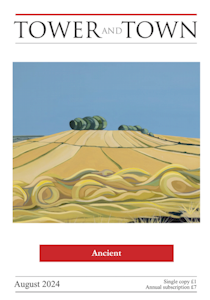

Tower and Town, August 2024 (view the full edition) (view the full edition)The Marlborough Bucket: A Masterpiece of Celtic ArtThe Marlborough bucket is no ordinary bucket! It was created to be the centrepiece of tribal gatherings and held over 100 litres of wine or beer. It bears the images of women, men and horses, flamboyant symbols of tribes that made alliances to fight Julius Caesar as he conquered Celtic Europe. Found in 1807 by workmen digging for gravel at St Margaret's Mead, on the west side of Marlborough, all that is left today are sheets of decorated bronze and corroded iron fittings. When discovered, it was still complete, with wooden staves and base, bound with iron bands, just like a modern barrel. It was decorated with three bronze strips of hammered repoussé decoration. Inside was cremated human bone, perhaps the remains of the last owner who had chosen to be buried with their most prized possession. Without the benefit of modern conservation techniques, the wood of the bucket disintegrated soon after its discovery, leaving only the metal fittings. The Bucket has been extensively studied by Dr Reb Ellis-Haken. Careful analysis of the decoration highlighted differences in the ways in which the horses have been groomed, their tails docked and manes dressed. These details are mirrored by coins and other artefacts, and suggest that the horses might be symbols of the Parisi and Senones tribes of Northern France. The Bucket was probably made in Northern France to cement tribal alliances made at the time of Caesar's Gallic Wars between 58 and 50BC, at a time when he also invaded Britain. Perhaps the bucket was brought to Britain by a defeated Gaulish leader, offered asylum by allies in Britain. But the most remarkable detail in the decoration are the human figures. Uniquely, women and men are both shown on the bucket, with distinctive hairstyles that may show their status in society. One face in particular stands out - the whites of the eyes are still highlighted by silver-coloured tin, and pupils that once shone with brilliant blue glass. The figurative decoration of the Marlborough Bucket is second only in Europe to the Danish Gundesrup Cauldron. Remarkably, until the new study by Dr Ellis-Haken, the Marlborough Bucket had been largely ignored by archaeologists. Today it is one of the treasures to be seen at the Wiltshire Museum in Devizes. Find out more by catching up on an online talk from the Museum website.  Dr David Dawson, Director, Wiltshire Musem |